Interesting Facts About Baby Wolves
Baby wolves, also known as wolf pups, are playful mammals not unlike their domesticated sibling species, the dog. Wolf cubs are raised by their entire pack, with males babysitting and non-breeding females producing milk. Baby wolves grow fast, becoming useful as hunters at 8 months of age.
Litter Size
Litter Size
Baby wolves, on average, are born in litters of four to six pups. "Litter mates" is the term used for the pups in a single litter.
Gestation
Gestation
A wolf pup's gestation period is between 63 and 65 days.
Features and Growth
Features and Growth
Wolf pups are born weighing about a pound, with no ability to see or hear. Blue at birth, the eyes of a wolf pup turn yellow between 8 and 16 weeks of age. At 2 weeks old, pups open their eyes and learn to walk, and grow teeth and leave the den a week later.
Habitat
Habitat
Female wolves give birth in caves or holes in the ground, called dens, which provide protection from the weather and predators.
Mortality
Mortality
Due to various diseases, malnutrition and starvation, the mortality rate of wild wolf pups is between 30 and 60 percent.
Fun Fact
Fun Fact
A very young wolf cub must have its mother massage its belly with her tongue in order to urinate.
Cite This Article
MLA
Emari, . "Interesting Facts About Baby Wolves" sciencing.com, https://www.sciencing.com/interesting-baby-wolves-6775073/. 22 November 2019.
APA
Emari, . (2019, November 22). Interesting Facts About Baby Wolves. sciencing.com. Retrieved from https://www.sciencing.com/interesting-baby-wolves-6775073/
Chicago
Emari, . Interesting Facts About Baby Wolves last modified March 24, 2022. https://www.sciencing.com/interesting-baby-wolves-6775073/
